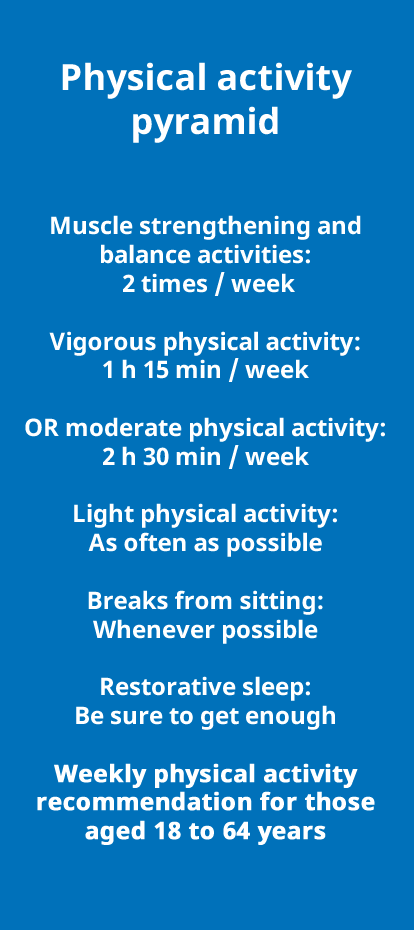You have 24 hours a day. How do you use your body during this time? Well-being demands sufficient sleep, and this forms the basis for planning your activity. Aims and situations vary, but physical activity should be properly balanced to promote your well-being. To help you plan your physical activity, check out the physical activity pyramid and pie diagram published by the UKK institute.
Three examples to help you plan your physical activity

Read these stories by three students of different ages and with different exercise habits. They can help you understand why physical activity matters and how you can use the physical activity pyramid when planning your own activity.
Viivi, 23, a business student: not enough easy everyday exercise, too little free time and sleep.
Viivi practises gymnastics and gym training 5 to 7 days a week. She also works in a shop a couple of nights a week. Because of her studies and her work, she sits for over 10 hours a day and does not really have time for everyday exercise such as cycling or walking. She has little free time to relax, and often gets too little sleep. In other words, Viivi ignores three basic areas of physical activity: sleep and recovery; taking breaks from sitting; and getting easy everyday exercise. These form a solid basis for physical well-being and help to prevent strain-related complaints. If there’s a lot of strain in all areas of life, you can burn yourself out. It’s good to think in which areas you could take it easier.
Jaakko, 35, an education student: easy everyday exercise is not enough to maintain muscle strength and endurance.
Jaakko spends his study and free time reading books and sitting at a computer. Every day he tries to exercise by walking and taking stairs instead of a lift. Despite this, he gets less than an hour’s meaningful exercise a day, so his physical activity level is quite low. Light everyday exercise isn’t enough to maintain or develop the muscle strength and endurance required to perform heavier tasks. Jaakko would therefore benefit from the upper sections of the physical activity pyramid. You can significantly improve your performance by doing just two heavier exercise sessions a week combining muscle strength and everyday exercise.
Taina, 51, a bioanalytics student: upper body strength training would be a boost to both daily life and studies.
Taina maintains her fitness by jogging three times a week. Because of her studies, she has to spend long periods of time in positions where her arms and shoulders remain static. This one-sided strain on her upper body continues in her free time, as she spends a lot of time at a computer. Jogging is a great way to maintain basic endurance. Taking breaks from static working positions and doing upper body strength training would help Taina manage better in her daily life.
Now think about your daily life and how much physical activity you engage in. To what extent do the different sections of the activity pyramid reflect your life? If you need more physical activity, start exercising little by little. Take the following test (available only in Finnish) and think about your next steps:
